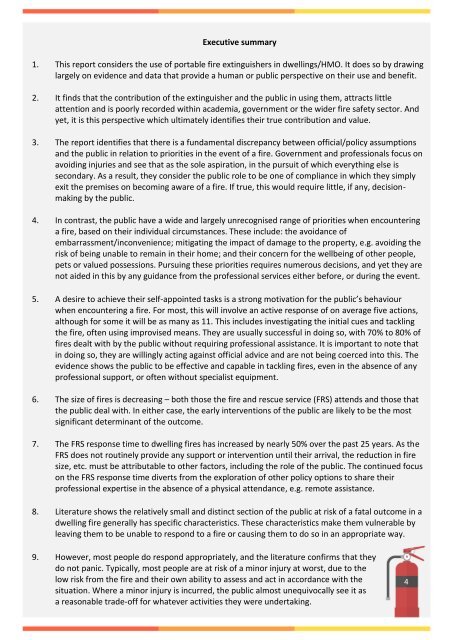An evaluation of the role of fire extinguishers
A report considering the role of a fire extinguisher in human terms identifying the gap between policy assumptions and the evidence from real fires. It considers the implications arising from this and makes a number of recommendations to create an evidence base and enhance current fire safety policies/advice.
A report considering the role of a fire extinguisher in human terms identifying the gap between policy assumptions and the evidence from real fires. It considers the implications arising from this and makes a number of recommendations to create an evidence base and enhance current fire safety policies/advice.
Create successful ePaper yourself
Turn your PDF publications into a flip-book with our unique Google optimized e-Paper software.
Executive summary<br />
1. This report considers <strong>the</strong> use <strong>of</strong> portable <strong>fire</strong> <strong>extinguishers</strong> in dwellings/HMO. It does so by drawing<br />
largely on evidence and data that provide a human or public perspective on <strong>the</strong>ir use and benefit.<br />
2. It finds that <strong>the</strong> contribution <strong>of</strong> <strong>the</strong> extinguisher and <strong>the</strong> public in using <strong>the</strong>m, attracts little<br />
attention and is poorly recorded within academia, government or <strong>the</strong> wider <strong>fire</strong> safety sector. <strong>An</strong>d<br />
yet, it is this perspective which ultimately identifies <strong>the</strong>ir true contribution and value.<br />
3. The report identifies that <strong>the</strong>re is a fundamental discrepancy between <strong>of</strong>ficial/policy assumptions<br />
and <strong>the</strong> public in relation to priorities in <strong>the</strong> event <strong>of</strong> a <strong>fire</strong>. Government and pr<strong>of</strong>essionals focus on<br />
avoiding injuries and see that as <strong>the</strong> sole aspiration, in <strong>the</strong> pursuit <strong>of</strong> which everything else is<br />
secondary. As a result, <strong>the</strong>y consider <strong>the</strong> public <strong>role</strong> to be one <strong>of</strong> compliance in which <strong>the</strong>y simply<br />
exit <strong>the</strong> premises on becoming aware <strong>of</strong> a <strong>fire</strong>. If true, this would require little, if any, decisionmaking<br />
by <strong>the</strong> public.<br />
4. In contrast, <strong>the</strong> public have a wide and largely unrecognised range <strong>of</strong> priorities when encountering<br />
a <strong>fire</strong>, based on <strong>the</strong>ir individual circumstances. These include: <strong>the</strong> avoidance <strong>of</strong><br />
embarrassment/inconvenience; mitigating <strong>the</strong> impact <strong>of</strong> damage to <strong>the</strong> property, e.g. avoiding <strong>the</strong><br />
risk <strong>of</strong> being unable to remain in <strong>the</strong>ir home; and <strong>the</strong>ir concern for <strong>the</strong> wellbeing <strong>of</strong> o<strong>the</strong>r people,<br />
pets or valued possessions. Pursuing <strong>the</strong>se priorities requires numerous decisions, and yet <strong>the</strong>y are<br />
not aided in this by any guidance from <strong>the</strong> pr<strong>of</strong>essional services ei<strong>the</strong>r before, or during <strong>the</strong> event.<br />
5. A desire to achieve <strong>the</strong>ir self-appointed tasks is a strong motivation for <strong>the</strong> public’s behaviour<br />
when encountering a <strong>fire</strong>. For most, this will involve an active response <strong>of</strong> on average five actions,<br />
although for some it will be as many as 11. This includes investigating <strong>the</strong> initial cues and tackling<br />
<strong>the</strong> <strong>fire</strong>, <strong>of</strong>ten using improvised means. They are usually successful in doing so, with 70% to 80% <strong>of</strong><br />
<strong>fire</strong>s dealt with by <strong>the</strong> public without requiring pr<strong>of</strong>essional assistance. It is important to note that<br />
in doing so, <strong>the</strong>y are willingly acting against <strong>of</strong>ficial advice and are not being coerced into this. The<br />
evidence shows <strong>the</strong> public to be effective and capable in tackling <strong>fire</strong>s, even in <strong>the</strong> absence <strong>of</strong> any<br />
pr<strong>of</strong>essional support, or <strong>of</strong>ten without specialist equipment.<br />
6. The size <strong>of</strong> <strong>fire</strong>s is decreasing – both those <strong>the</strong> <strong>fire</strong> and rescue service (FRS) attends and those that<br />
<strong>the</strong> public deal with. In ei<strong>the</strong>r case, <strong>the</strong> early interventions <strong>of</strong> <strong>the</strong> public are likely to be <strong>the</strong> most<br />
significant determinant <strong>of</strong> <strong>the</strong> outcome.<br />
7. The FRS response time to dwelling <strong>fire</strong>s has increased by nearly 50% over <strong>the</strong> past 25 years. As <strong>the</strong><br />
FRS does not routinely provide any support or intervention until <strong>the</strong>ir arrival, <strong>the</strong> reduction in <strong>fire</strong><br />
size, etc. must be attributable to o<strong>the</strong>r factors, including <strong>the</strong> <strong>role</strong> <strong>of</strong> <strong>the</strong> public. The continued focus<br />
on <strong>the</strong> FRS response time diverts from <strong>the</strong> exploration <strong>of</strong> o<strong>the</strong>r policy options to share <strong>the</strong>ir<br />
pr<strong>of</strong>essional expertise in <strong>the</strong> absence <strong>of</strong> a physical attendance, e.g. remote assistance.<br />
8. Literature shows <strong>the</strong> relatively small and distinct section <strong>of</strong> <strong>the</strong> public at risk <strong>of</strong> a fatal outcome in a<br />
dwelling <strong>fire</strong> generally has specific characteristics. These characteristics make <strong>the</strong>m vulnerable by<br />
leaving <strong>the</strong>m to be unable to respond to a <strong>fire</strong> or causing <strong>the</strong>m to do so in an appropriate way.<br />
9. However, most people do respond appropriately, and <strong>the</strong> literature confirms that <strong>the</strong>y<br />
do not panic. Typically, most people are at risk <strong>of</strong> a minor injury at worst, due to <strong>the</strong><br />
low risk from <strong>the</strong> <strong>fire</strong> and <strong>the</strong>ir own ability to assess and act in accordance with <strong>the</strong><br />
situation. Where a minor injury is incurred, <strong>the</strong> public almost unequivocally see it as<br />
a reasonable trade-<strong>of</strong>f for whatever activities <strong>the</strong>y were undertaking.<br />
4




